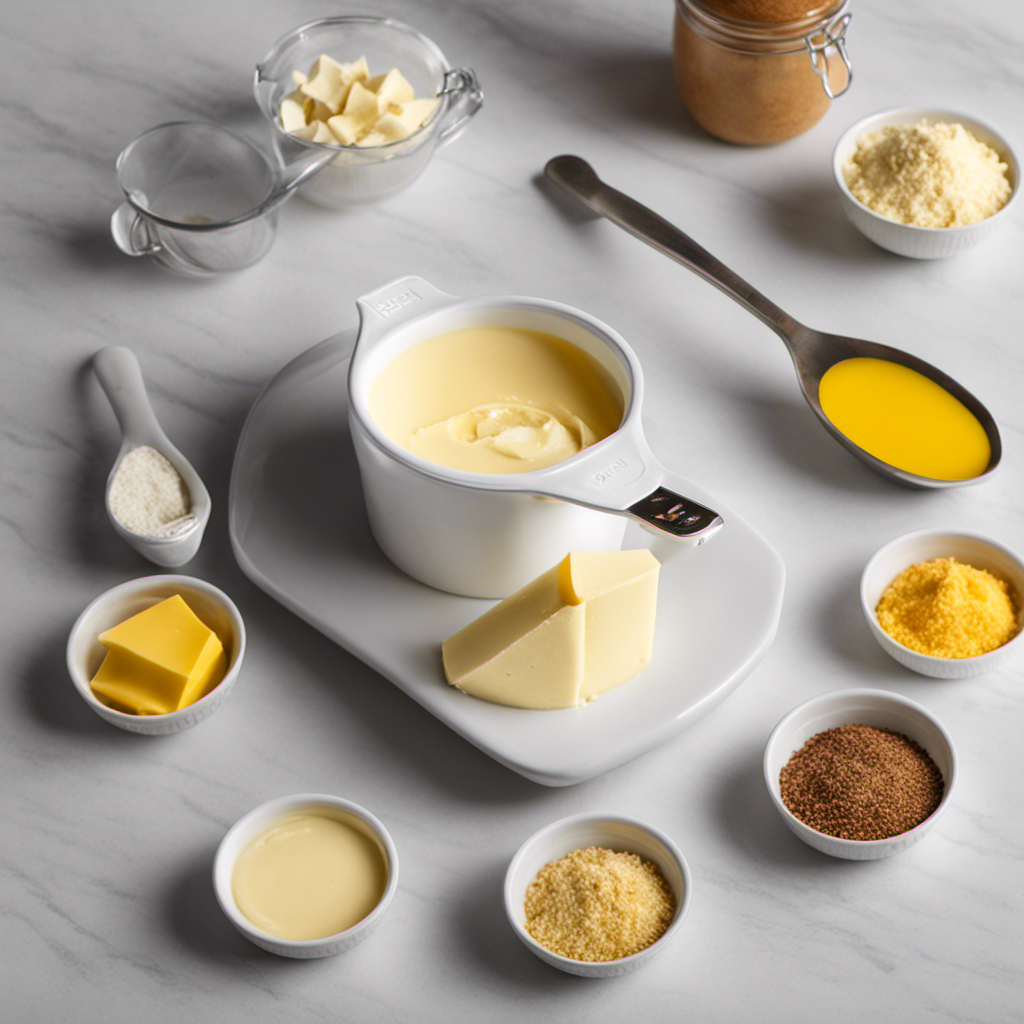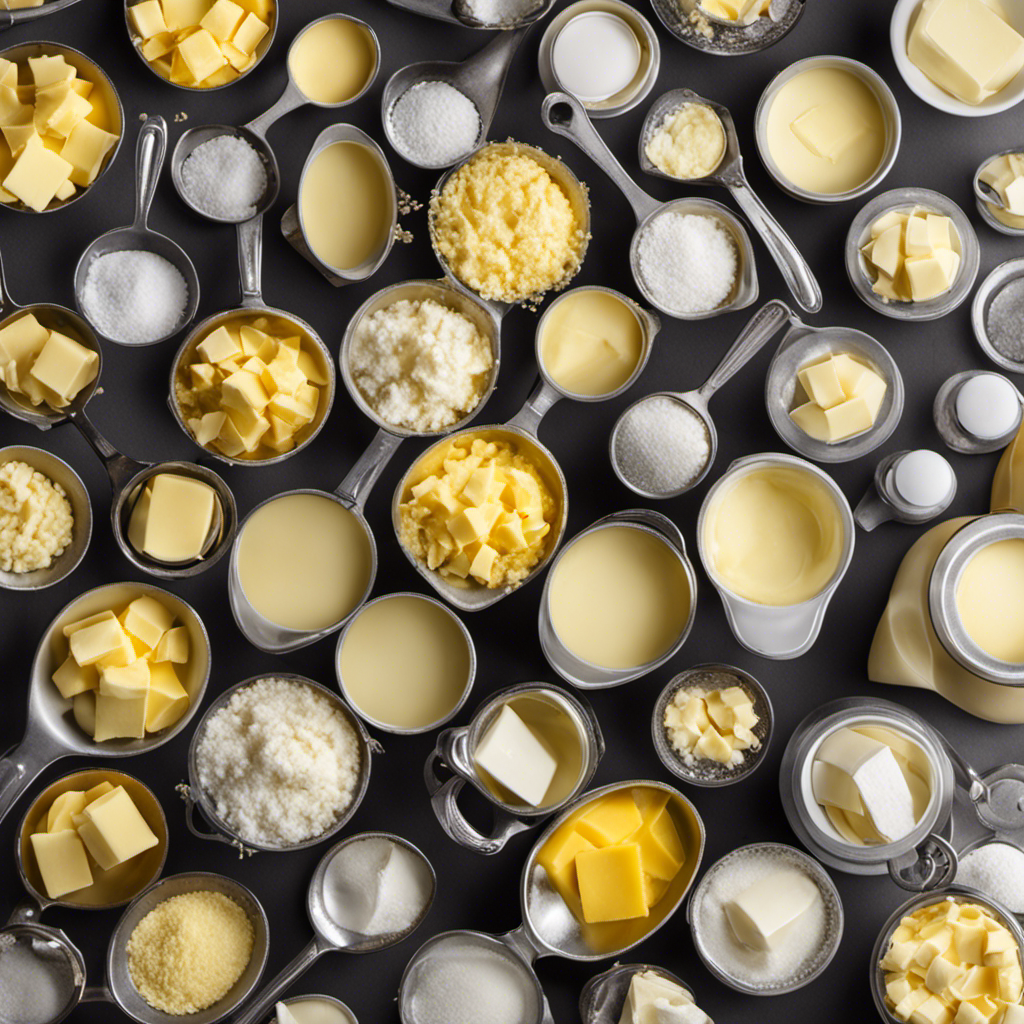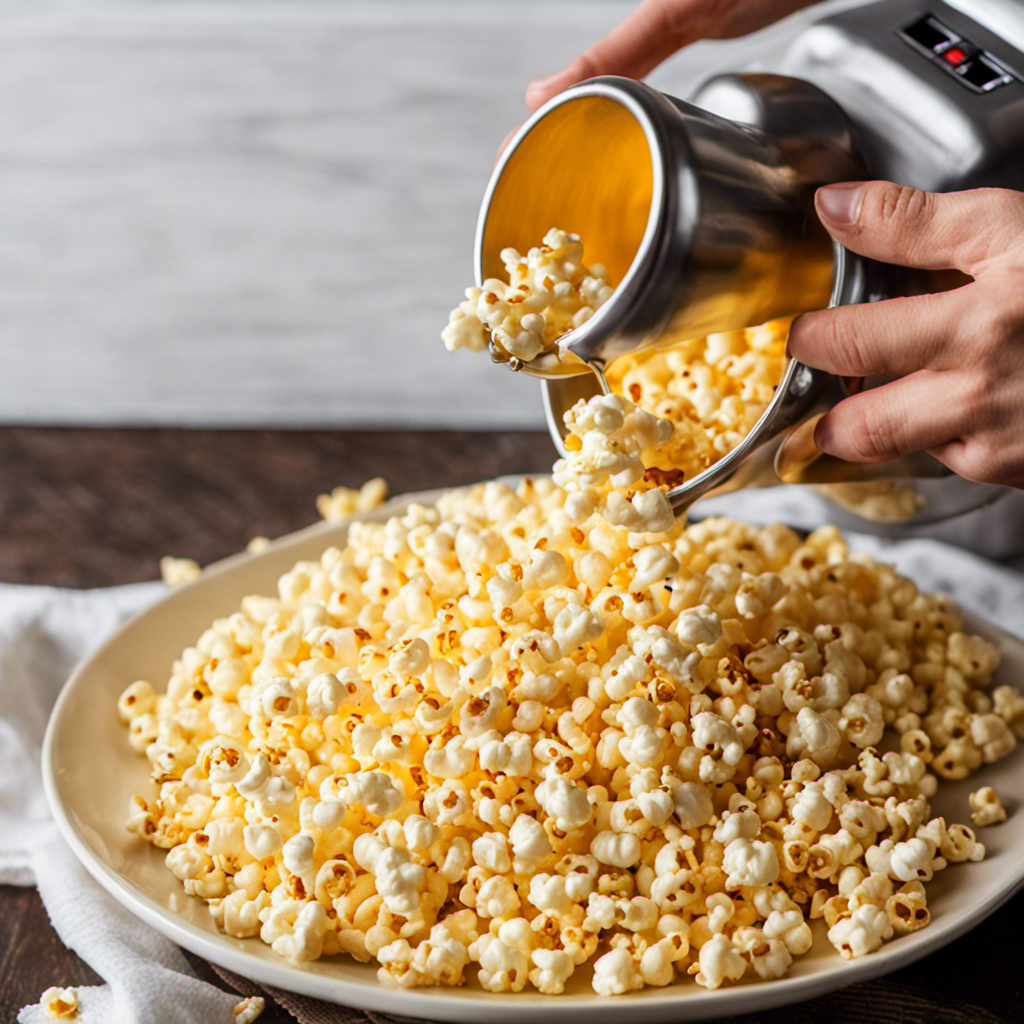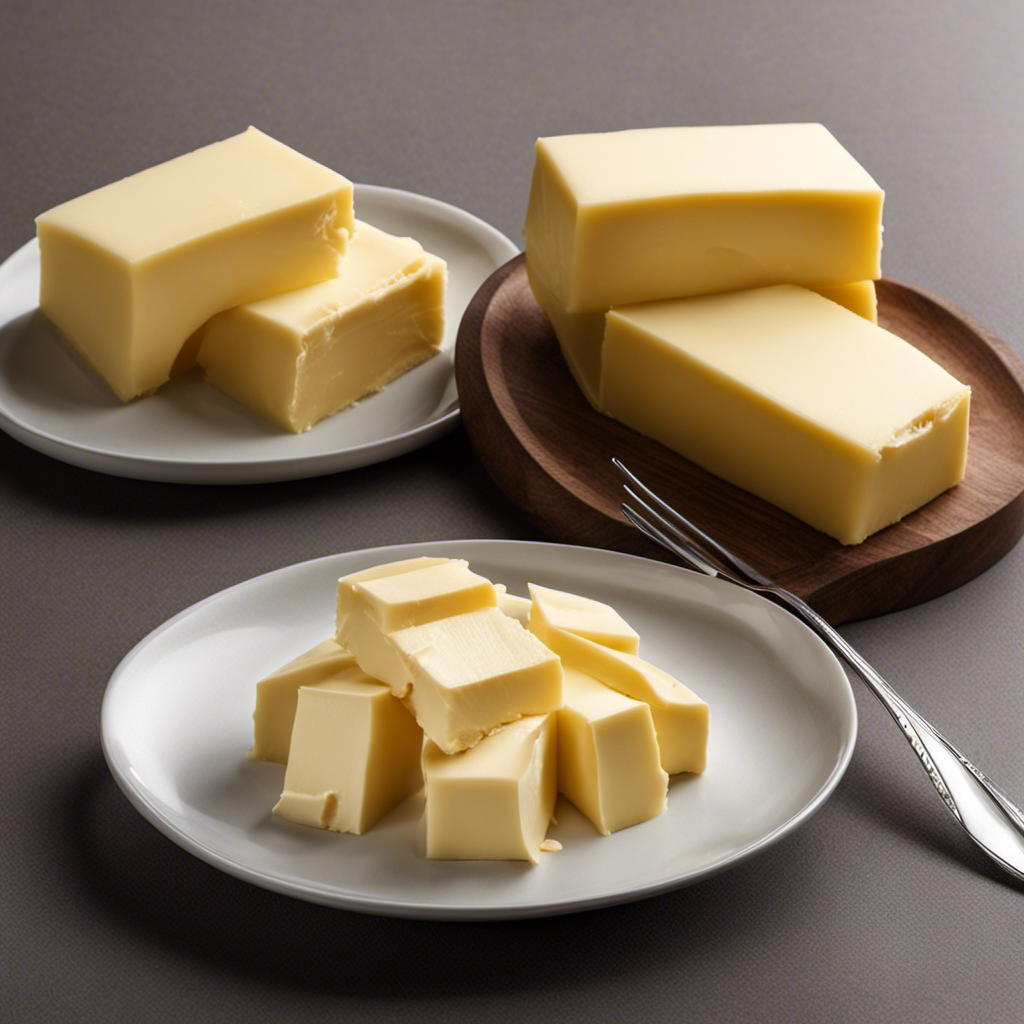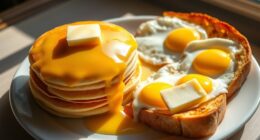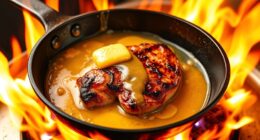You might be wondering: why should I care about the number of tablespoons in a cup of butter? Allow me to explain, grasping the specifics of butter measurements is crucial for anyone who enjoys cooking or baking at home.
Whether you’re following a recipe or creating your own, knowing the conversion from cups to tablespoons can make all the difference. In this article, I will break down the standard cup-to-tablespoon ratio for butter and provide handy tips for accurate measurements.
So, let’s dive in and conquer the world of butter measuring!
Key Takeaways
- Understanding the cup to tablespoon ratio for butter is essential for home cooks and bakers to achieve recipe accuracy and culinary success.
- Measuring butter in cups can be tricky due to its solid form, but using a scale for accurate measurements in grams or ounces or using tablespoons as an alternative can help.
- Precise butter measurements can be achieved by using equivalent measurements such as 1 stick of butter equals 1/2 cup or 8 tablespoons, and 1/4 cup of butter equals 1/8 cup or 4 tablespoons.
- To ensure recipe accuracy and consistency, it is important to weigh butter for precise measurements, properly soften it at room temperature, and use measuring cups and spoons for accurate measurements of both dry and wet ingredients. Following recipe instructions is also crucial for consistent results.
Understanding Butter Measurements
There’s 1 cup of butter, but how many tablespoons is that?
Understanding butter measurement equivalents is crucial for recipe accuracy. In baking and cooking, precise measurements are essential to achieve the desired results.
When it comes to butter, a common ingredient in many recipes, it is helpful to know the conversion between cups and tablespoons. In the United States, 1 cup of butter is equal to 16 tablespoons. This means that if a recipe calls for 1 cup of butter, you can easily convert it to tablespoons by multiplying it by 16.
Having this knowledge ensures that your recipes turn out just right, eliminating any guesswork and guaranteeing culinary success.
Converting Cups to Tablespoons in Butter
When it comes to measuring butter, understanding the cup to tablespoon ratio is essential. This knowledge allows for accurate measurements in recipes and ensures the right amount of butter is used.
Cup to Tablespoon Ratio
The cup to tablespoon ratio is 16 to 1. Understanding butter measurements is crucial for recipe accuracy and consistency. Here are two important things to know about butter measurements:
-
Measuring butter in cups can be tricky because it is a solid ingredient that can be packed tightly or loosely. Using a scale to measure butter in grams or ounces is the most accurate method.
-
If you don’t have a scale, using tablespoons is a convenient alternative. Remember that 1 cup of butter is equal to 16 tablespoons. This ratio remains consistent regardless of the butter’s density or brand.
Knowing the cup to tablespoon ratio helps ensure your recipes turn out just right. Now, let’s explore other butter measurement equivalents to expand your cooking knowledge.
Butter Measurement Equivalents
To expand your cooking knowledge, let’s explore other ways to measure butter. A precise way to measure butter is by weight, as understanding butter density is crucial for accurate measurements. By using a kitchen scale, you can easily measure the exact amount of butter needed for your recipe. Here is a table that shows the equivalent measurements for different amounts of butter in cups, tablespoons, and grams:
| Amount of Butter | Cups | Tablespoons | Grams |
|---|---|---|---|
| 1 stick | 1/2 | 8 | 113 |
| 1/4 cup | 1/8 | 4 | 57 |
| 1/2 cup | 1/4 | 8 | 113 |
| 1 cup | 1 | 16 | 227 |
| 2 cups | 2 | 32 | 454 |
The Standard Cup-to-Tablespoon Ratio for Butter
When it comes to cooking, accurate measurements are crucial for recipe success. One area that often requires conversion is butter measurements. Understanding the standard cup-to-tablespoon ratio for butter can help ensure recipe accuracy and consistency.
In this discussion, we will explore the conversion factor for butter, as well as touch on other common cooking measurements to help you become a more confident and precise cook.
Butter Measurement Conversion
There are 16 tablespoons in 1 cup of butter. Understanding butter ratios and measuring accurately can be key in achieving the perfect texture and taste in your recipes. Here are some tips to help you measure butter accurately:
-
Use a kitchen scale: Weighing the butter will provide the most precise measurement, especially when dealing with recipes that require specific ratios.
-
Use tablespoon markings: Most butter packaging has tablespoon markings on the wrapper, making it easy to measure without the need for extra tools.
-
Soften the butter properly: When a recipe calls for softened butter, make sure it is at room temperature. This will ensure accurate measurements and help incorporate the butter evenly into the recipe.
-
Use a butter dish: If you prefer to keep butter at room temperature for everyday use, consider using a butter dish with tablespoon markings to ensure consistent measurements.
Common Cooking Measurements
Understanding liquid measurements is essential in cooking and baking. It allows you to follow recipes accurately and achieve the desired results. One common conversion that often comes up is converting ounces to cups. This is particularly important when dealing with liquids like milk, water, or oil.
To convert ounces to cups, you need to know that there are 8 fluid ounces in 1 cup. So, if you have 16 fluid ounces of liquid, you would divide that by 8 to get the equivalent in cups, which is 2 cups. Similarly, if you have 32 fluid ounces, you would divide that by 8 to get 4 cups.
Having a good understanding of liquid measurements and being able to convert between different units will greatly improve your cooking and baking skills. It ensures that you use the right amount of ingredients and ultimately leads to delicious and successful dishes.
Recipe Accuracy and Consistency
To achieve recipe accuracy and consistency, make sure you accurately measure your ingredients using the appropriate tools. Understanding recipe accuracy and maintaining consistency are essential for successful cooking and baking. Here are some key tips to help you achieve this:
-
Use measuring cups and spoons: These tools are specifically designed to provide accurate measurements. Avoid using regular kitchen utensils as they may not give you the precise amount needed.
-
Level off dry ingredients: When measuring flour, sugar, or any other dry ingredients, use a straight edge (like the back of a knife) to level off the excess and ensure an accurate measurement.
-
Spoon and level wet ingredients: For liquids like milk or oil, use a measuring spoon or cup that allows you to pour and level off the ingredient.
-
Follow the recipe instructions: Carefully read the recipe and follow the specified measurements. Even small variations can affect the final outcome.
How to Measure Butter in Tablespoons
You can easily measure butter in tablespoons by dividing the number of cups by 16. This is a simple and accurate way to convert butter measurements when you need a precise amount for your recipe.
Measuring butter accurately is important because it can affect the texture and taste of your baked goods. Using too much or too little butter can lead to a dense or dry result. By converting butter measurements to tablespoons, you can ensure that you are adding the right amount to your recipe.
For example, if a recipe calls for 1 cup of butter, you would divide that by 16 to get 8 tablespoons. This allows for consistency and accuracy in your baking, resulting in delicious and successful treats.
Converting Butter Measurements for Recipes
When it comes to baking, understanding butter measurement conversions is essential. Knowing how many tablespoons are in a cup of butter can save you time and ensure accurate results in your recipes.
Converting butter measurements for recipes can be a simple process once you have the right information and tools at hand.
Butter Measurement Conversions
There’s 16 tablespoons in 1 cup of butter. Understanding butter ratios and converting butter measurements is essential for successful baking and cooking. Here are some key points to help you navigate butter measurement conversions:
-
When a recipe calls for butter in cups, you can easily convert it to tablespoons by multiplying the number of cups by 16.
-
Similarly, if a recipe provides a measurement in tablespoons and you prefer to use cups, divide the number of tablespoons by 16.
-
Keep in mind that butter can be measured in different ways, such as by weight or volume. It’s important to follow the specific measurement called for in your recipe to ensure accurate results.
-
Remember to use precise conversions for butter ratios to maintain the right balance and texture in your dishes.
Now that you understand the basics of butter measurement conversions, let’s dive into the details of how many tablespoons are in a cup.
Tablespoons in a Cup
Now that we have a better understanding of butter measurement conversions, let’s focus on the specific question of how many tablespoons are in a cup of butter.
To answer this, we need to know that there are 16 tablespoons in 1 cup. This means that if a recipe calls for 1 cup of butter and you want to use tablespoons instead, you would need 16 tablespoons.
It’s important to note that different countries may have different measurements for tablespoons and cups, so it’s always a good idea to check the specific conversion for your region.
Additionally, if you prefer to use grams instead of tablespoons, you can convert the amount by knowing that 1 tablespoon of butter is equal to approximately 14 grams.
Understanding these conversions will help you accurately substitute butter in your recipes.
Speaking of which, let’s now explore how to convert measurements for recipes.
Converting for Recipes
To accurately convert measurements for recipes, it’s helpful to have a good understanding of different measurement units and their equivalents. When it comes to understanding butter measurements, it is important to know the conversion between cups and tablespoons.
Here are a couple of key points to keep in mind:
- Butter is commonly measured in cups and tablespoons.
- 1 cup of butter is equal to 16 tablespoons.
- 1 tablespoon of butter is equal to 1/16 of a cup.
Having this understanding of butter measurements is crucial for recipe accuracy. Whether you’re baking a cake or making a savory dish, knowing the precise amount of butter needed can make a significant difference in the outcome of your recipe.
Now, let’s delve into the specifics of converting cups to tablespoons when it comes to butter.
Butter Equivalents: Cups to Tablespoons
In 1 cup of butter, there are 16 tablespoons. Understanding butter measurements and the equivalents can be helpful in cooking and baking.
When a recipe calls for a certain amount of butter in cups, it’s important to know the equivalent measurement in tablespoons. This knowledge allows for accurate measurements and ensures the desired outcome of the recipe.
For example, if a recipe calls for 1/2 cup of butter, you would need 8 tablespoons. Similarly, if a recipe calls for 1/4 cup of butter, you would need 4 tablespoons.
Having a clear understanding of these butter measurement equivalents helps in following recipes precisely and achieving consistent results. So, the next time you come across a recipe that requires butter, you will know exactly how many tablespoons to use.
Calculating Tablespoons in a Cup of Butter
You can calculate the number of tablespoons in a cup of butter by multiplying it by 16. Understanding butter consistency is important for accurately measuring butter in recipes.
Here are some key points to keep in mind:
-
Consistency Matters:
-
Butter can come in different consistencies, such as solid, softened, or melted.
-
Solid butter is typically measured by cutting it into tablespoons or using a butter dish with tablespoon markings.
-
Accurate Measurement Techniques:
-
Softened butter can be measured by packing it into a measuring cup or using a tablespoon.
-
For melted butter, pour it into a liquid measuring cup and use a tablespoon to measure the desired amount.
-
Conversion Tips:
-
If a recipe calls for 1 cup of butter and you only have tablespoons, simply divide the number of tablespoons needed by 16 to get the equivalent in cups.
Handy Tips for Measuring Butter in Tablespoons
When measuring butter, it’s important to keep in mind the different consistencies it can come in, such as solid, softened, or melted. To measure butter accurately, it is best to use tablespoons as a unit of measurement.
One stick of butter is equal to 8 tablespoons or 1/2 cup. This can be useful when converting butter for spreads or recipes that require precise measurements.
If your butter is in a solid state, you can easily measure it by cutting it into tablespoon-sized increments. For softened butter, you can use a measuring spoon or scoop it into tablespoons. When dealing with melted butter, you can pour it into a liquid measuring cup and convert the amount to tablespoons.
Adjusting Butter Measurements for Different Recipes
To adjust your butter measurements for different recipes, consider the specific requirements and quantities of each dish. Accurate butter measurements are crucial in baking, as they directly affect the texture, flavor, and overall outcome of your baked goods.
Here are a few tips to help you adjust your butter measurements effectively:
-
When reducing butter:
-
Substitute with an equal amount of unsweetened applesauce or mashed banana for a lower-fat option.
-
Opt for a reduced-fat butter or margarine to maintain some of the buttery flavor.
-
When increasing butter:
-
Use a 1:1 ratio when substituting vegetable oil for butter in recipes.
-
Consider using clarified butter for a richer and smoother texture.
Converting Butter Measurements for Baking
Converting butter measurements for baking can be done by substituting with alternative ingredients or using clarified butter for a richer texture. Understanding butter ratios is essential for accurate butter measurements in recipes. To help you convert butter measurements, here is a table that shows the equivalent measurements for butter in tablespoons, cups, and grams:
| Butter Measurement | Tablespoons | Cups | Grams |
|---|---|---|---|
| 1 stick | 8 | 1/2 | 113 |
| 1/2 cup | 8 | 1 | 113 |
| 1 cup | 16 | 2 | 226 |
| 2 cups | 32 | 4 | 452 |
| 4 cups | 64 | 8 | 904 |
With this table, you can easily convert butter measurements in your baking recipes. Whether you need to substitute with alternative ingredients or use clarified butter, you can now achieve accurate butter measurements for the perfect bake.
Common Mistakes When Measuring Butter in Tablespoons
One common mistake is not properly measuring the amount of butter needed for a recipe. When it comes to baking, precision is key, and even a small error in measuring butter can affect the final result. To avoid this, here are some common measurement errors to watch out for:
-
Eyeballing the amount: It’s easy to estimate the amount of butter needed, but this can lead to inaccurate measurements. Always use a measuring spoon or scale for precise results.
-
Using the wrong conversion: Converting tablespoons to cups can be confusing, especially when it comes to butter. Remember that there are 16 tablespoons in 1 cup of butter.
Frequently Asked Questions
Can I Use Margarine Instead of Butter in Recipes That Call for Tablespoons of Butter?
Yes, you can use margarine instead of butter in recipes that call for tablespoons of butter. However, keep in mind that butter has more health benefits compared to margarine, so it’s worth considering.
How Do I Measure Butter in Tablespoons if I Don’t Have a Tablespoon Measuring Tool?
To measure butter without a tablespoon, you can use the conversion of 1 tablespoon equals 3 teaspoons. So if a recipe calls for 1 cup of butter, that would be equivalent to 16 tablespoons or 48 teaspoons.
What Is the Difference Between Salted and Unsalted Butter When Measuring in Tablespoons?
The difference between salted and unsalted butter when measuring in tablespoons is the amount of salt added. Using unsalted butter in baking allows for better control of the salt content.
Can I Substitute Oil for Butter When Measuring in Tablespoons?
Yes, you can substitute oil for butter when measuring in tablespoons. However, keep in mind that oil has a different consistency and flavor. Other alternative butter options include margarine and shortening.
How Can I Convert Tablespoons of Butter to Grams or Ounces?
To convert tablespoons of butter to grams or ounces, you can use equivalent measurements. It’s important to understand the conversion factor for butter and then apply it to get the desired result.
Conclusion
So there you have it, folks! After diving deep into the world of butter measurements, we can confidently say that there are 16 tablespoons in 1 cup of butter.
It may seem like a lot, but hey, who’s counting? Well, actually, we are. Because when it comes to cooking and baking, precision is key.
So next time you’re whipping up a delicious recipe, remember to measure your butter accurately. Trust me, your taste buds will thank you.
Now go forth, armed with the knowledge of tablespoons and cups, and create culinary masterpieces!
